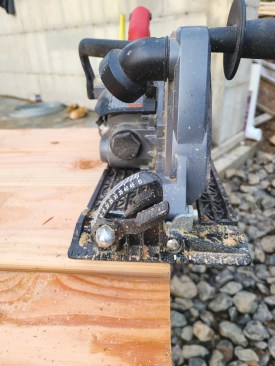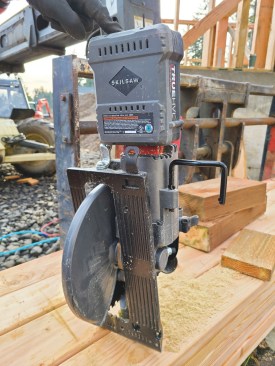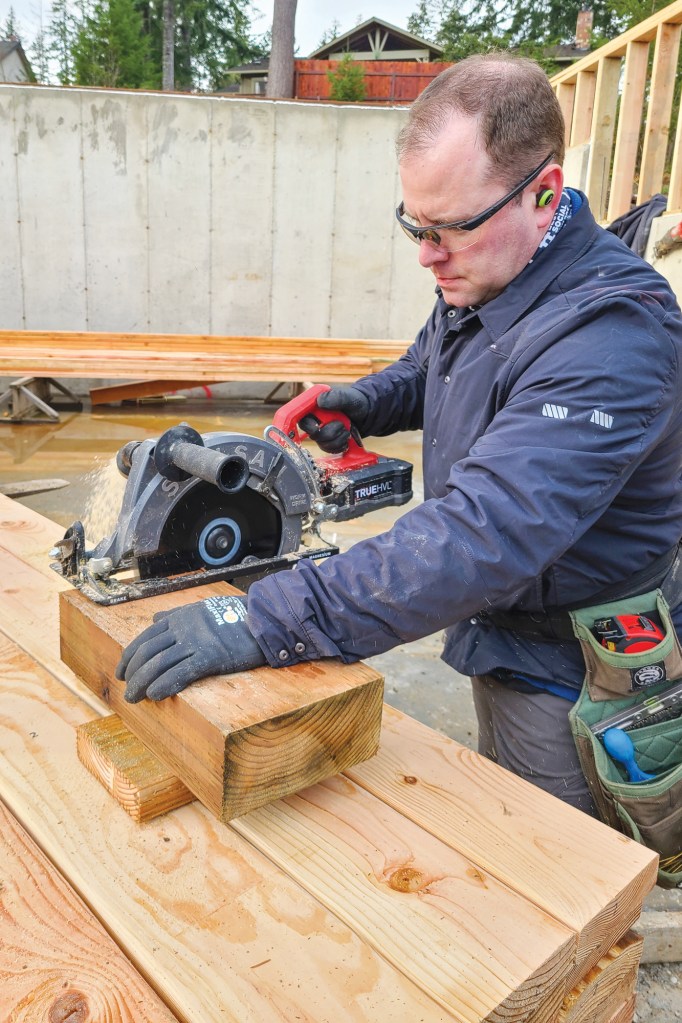Until recently, the last power tool that we’ve had to plug into a 110V outlet was one of our 10 1/4-inch beam saws, which see quite a bit of use on our framing jobs. Besides being useful for cutting headers, beam saws allow me to cut my wall plates two at a time so that they are identical, though I’ve had to put that practice on hold as we’ve moved more and more toward cordless tools. But now, with the introduction of Skilsaw’s new Truehvl 10 1/4-inch worm drive saw, we are 100% cordless with power tools and quickly cutting double plates again.
Features
This is a true 10 1/4-inch wormdrive saw, designed from the ground up for a larger blade, with no need to be adapted with an add-on kit. For example, the blade brake—a must-have feature on any saw, but especially on one with a larger blade—works flawlessly. With a depth of cut of 3 11/16 inches, the saw can easily cut through a 4×4 in a single pass, and it’s a great saw to cut I-joists that are too wide for a 7 1/4-inch saw. It can also cut bevels to 51 degrees.
My kit shipped with only one battery. For me, this isn’t a problem, as I don’t cut as much lumber using a saw like this as I do with a standard 7 1/4-inch saw; in fact, I haven’t managed to drain the battery yet in the few weeks or so that we’ve had the saw on our jobsites. I don’t think I’ll ever have a problem, since I can throw the battery on the charger at lunch, basically guaranteeing I’ll never run out of juice.

The blade-left saw, which has an electric brake and a built-in dust port, can be tilted to make bevel cuts of up to 51 degrees.
Though the saw weighs close to 20 pounds, it doesn’t feel unwieldy or heavy on my wrist. With the big battery attached under the rear handle, it is very well-balanced.
The upper guard is equipped with a dust port, which discharges most of the sawdust during a cut. I probably wouldn’t ever feel the need to use dust collection with this saw, but not having sawdust all over my cutting area is not a bad thing. Even without a vacuum hooked up to the saw, most of the dust is directed out of the dust port and off to the side.
The saw comes with a rafter hook, which works fine on joists, though it took a little head-scratching to figure out how to get it to play nice with our sawhorses. Basically, the battery hanging off the back of the saw tends to get in the way, but it’s not an issue worth griping about.

The beam saw also features a rafter hook, which the author found works fine on rafters, but not so much on sawhorses.
Another minor quibble is the button on the rear handle, which has to be pressed before the trigger will work. It was a slight hassle at first, but then I got used to it.
Power
There is a lot I could talk about when it comes to the general attributes and characteristics of wormdrive gears, but I think that would be a waste of time in this review. Let’s put it this way: The first time I adapted a 7 1/4-inch Skil worm drive to accept a 10 1/4‑inch blade was in 2002. At the time, our electrician told me that the larger blade would cause us to burn up the motor; almost 20 years later, that saw is still going strong. Sure, we did burn up another saw, but that one was on us (it’s important to use a large-gauge cord with those saws).
The beauty of the cordless version of the saw is that you can’t burn it up by using a cheap, light-gauge extension cord. In fact, you don’t need any cord. If you price the 10 1/4-inch corded version of this saw with a good cord (which may need to be replaced yearly because of damage and nicks), it’ll run you about $400, plus another $100 for the cord. So, for $500 you can have a great corded saw—or you can spend the extra $200 and get a great cordless version for $700. That is a lot of money, but by not running a cord, you will make up that money quickly: no more tripped breakers, no trip hazard, and no rolling out and rolling up cords. It adds up quickly. Put another way, if I backed over our cordless Skilsaw with a forklift and destroyed it, I’d buy another one that same day. skilsaw.com
Photos by the author.
